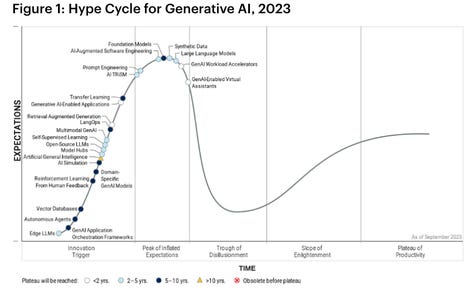Since the release of ChatGPT almost a year ago, generative AI has been booming, with companies developing or adopting AI models. A new report from Gartner shows that growth will only increase in the years to come.
The research firm predicts that 80% of companies will have used APIs (application programming interfaces) or generative AI models, or developed their own models by 2026.
This means that in just three years, the number of companies adopting or creating generative AI models will have increased sixteen-fold since, according to Gartner data, less than 5% of companies have done so in 2023.
“Generative AI has become a top priority and has driven tremendous innovation with new tools,” said Arun Chandrasekaran, an analyst at Gartner.
The research firm has outlined some of the innovations expected to have a massive impact on organizations over the next ten years, including:
- Applications based on generative AI
- Basic models of AI
- And AI Trust, Risk, and Security Management (AI TRiSM)
Applications based on generative AI
Generative AI-based applications are applications that leverage generative AI to accomplish a specific task. ChatGPT is an example of an AI-based generative application, as it uses AI to synthesize your text prompts and produce a response.
Organizations can adopt these applications to make employees’ jobs easier or to provide customer experiences that improve their services.
“The most common model today is text-to-X, which democratizes employee access to what were previously specialized tasks, through prompt engineering using natural language,” said Chandrasekaran in the report.
A prime example of this is the growing number of consulting firms adopting or developing their own AI models to make it easier for clients to find the resources they need in the firm’s vast databases.
The problem with these apps is that they are prone to hallucinations and inaccurate responses that make their reliability questionable.
Basic models of AI
Core models refer to the machine learning models that underpin generative AI applications, for example, what GPT is to ChatGPT.
These base models are trained on large amounts of data and are used to power different applications capable of accomplishing a wide variety of tasks.
Gartner placed core models at the top of the Hype Cycle’s inflated expectations, predicting that by 2027 they will underpin 60% of natural language processing (NLP) use cases.

Gartner
“Technology leaders should start with models with high accuracy, those that have significant ecosystem support, and that have adequate corporate safeguards around security and privacy,” Chandrasekaran said.
AI TRiSM – Trust, Risk, and Security Management
Finally, AI TRiSM refers to the set of solutions making it possible to resolve problems linked to generative AI models and to guarantee the success of their deployment.
Risks to generative AI models include reliability, misinformation, bias, privacy, and fairness.
If not handled properly, these issues can be particularly damaging to organizations, as they risk leaking sensitive data and spreading misinformation throughout the organization.
“Organizations that do not consistently manage AI risks are prone to experiencing negative outcomes, such as project failures and breaches,” Chandrasekaran said.
AI TRiSM is therefore crucial for organizations to minimize these risks and protect their organization members.
Source: “ZDNet.com”
